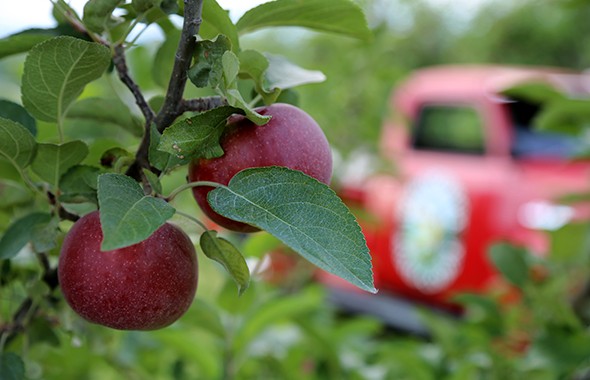The Working Landscape. Growing More Apples for Cider in Vermont.
June 20, 2014

You could say we Give a ‘Chuck™ about apples. As a craft cider, we don’t have mass market beer brands to fall back on. It’s cider or bust for us. Cider has been our sole focus for 23 years and that will continue as we prepare to open our new cidery.
An Apple Shortage?
Recent headlines have pointed to growing concerns over an apple shortage. The specific varieties that are in short supply are sometimes called “spitters”. As in, if you were to bite into one, you would probably spit it out. Yet when these hard bitter apples are crushed for juice, they make good cider.
The cider category is growing incredibly fast. Three years ago there was just a handful of cider makers, today the United States Association of Cider Makers boasts more than 200 members. The demand is coming from the orchard and craft segments of the cider category, as large commercial ciders source this type of juice from Europe. These particular apple varieties haven’t been grown on a large scale in the United States for more than a century. In the lead up to prohibition, acres and acres of heirloom cider fruit varieties were ripped out of the ground and even burned as farmers came under pressure from the temperance movement. The orchards were never replanted.
There are pockets of the country where “spitter” apples are grown today, but not in the numbers needed to meet the rising demand of a booming industry. Adding to the intrigue, an orchard is not exactly a wheat field. It takes an apple tree three to five years to bear usable fruit. There is no overnight fix. While some see this as a looming crisis, we see it as an opportunity to revitalize both a centuries old crop and local economies across the country.
Addison County is known for some pretty darn tasty apples. The weather in the Champlain Valley (the region that lies between the Green Mountains of Vermont and the Adirondacks of New York) is ideal for apple growing. Woodchuck®, which is also located in Addison County, partners with multiple orchards to source as much local fruit as possible for our ciders.
Vermont orchards grow predominately common eating apple varieties. Farmers can get the highest price for their fruit by selling these types of apples to market. 85% of the Vermont apple crop is sold into stores as fresh fruit. The remaining 15% goes to process, meaning cider, pies, applesauce, apple butter and beyond. Woodchuck buys roughly 40% of the processed apples in Vermont. If we were to buy any more than that, we could adversely affect our orchard partners’ bottom lines. Obviously, that is never the goal.
Woodchuck uses a wide variety of apples including fresh fruit, heirloom, and bittersweet varieties. The fresh eating varieties, such as McIntosh, Cortland and Gala are in the greatest supply and make up the majority of our ciders. They are fantastic apples and they make great ciders. Yet our spirit of innovation has led us to experiment with any number of the roughly 7,500 apple varieties that are out there.
The Working Landscape
Here is the thing about Vermont: it is a true community of people and not just some arbitrary border on a map. Vermonters rally around causes big and small, support their neighbors, and have no fear of implementing innovative strategies for bettering the state’s working landscape.
‘The Working Landscape’ is an important term. Vermont is a state of just over 600,000 people. There is a lot of open land and not all that many large scale employers. The state’s economy ticks in large part due to innovative businesses and industries that are changing the traditional rules of success. Sometimes a great idea just needs an extra push for the vision to be fully realized. Enter the Working Lands Enterprise Initiative. It came into being through an act of the Vermont Legislature. They realized that Vermont’s future is in the hands of the people and the people need proper tools to find fresh ways to use the land.
The initiative hands out more than 35 grants worth more than a million dollars each year. The grants provide needed funds for projects as varied as farmers growing vegetables year round to a hardwood company investing in a portable sawmill powered by the sun. It’s collaboration to keep the economy moving forward.
What exactly does this have to do with cider? Well, with cider being our livelihood, this potential apple shortage has been on our radar for a while. The success and growth of our orchard partners is vital to our own success.
What if we could start planting more apples, including of the “spitter” variety, on dormant Vermont farmland? Could it be done in a way that is profitable for the apple growers of our home state? Is there a viable economic model for such an idea?
Working with the University of Vermont’s (UVM) Department of Plant and Soil Science, we hope to find answers to those questions. UVM received a working land grant to study the idea and Woodchuck made a $10,000 match. We will also open our cidery up to horticulturists so they can conduct research on the apples grown.
The growing concern about an apple shortage is a short term hiccup that presents long term opportunities. Opportunities to diversify the apple crop, grow the local economy in an innovative way, and maybe in the process develop a Napa Valley of cider. Will Vermont grow enough apples to supply all the orchard and craft cider makers across the country? Probably not. We hope instead to create a new business model that can be duplicated. A model that yields the finest fruit and benefits both grower and producer, all while putting the working landscape to use in a new way. That is after all… The Vermont Way.
 Back to Blog
Back to Blog


